Hello again audio friends,
I was recently gifted with a pair each of MarkAudio Alpair 6m Gen2 and Dayton RS225-8 and would like to build a set of FAST (WAW if you will) 2-way floorstanders.
Before you ask, I don't have the equipment to take direct measurements myself, so I have been designing the crossover based on the manufacturer graphs. I have included .frd and .zma files I have been working with. Dayton has actual files from partexpress and I used a tracer program for the Alpairs.
I want the front baffle to be 10 inches wide which would be a baffle step at around 450 Hz. As such, I figured that would be a good crossover point. I have been playing around in WinPCD. I tried to do first order on both, but I didn't like how the response looked. So I tried first order on the woofer + zobel and second order on the Alpair (with polarity reversed) and think they look better.
Woofer: 4mH coil, zobel 20uF + 10ohm. Tweeter: 35uF + 2mH.
That said, and I'm sure you could tell, I don't really know what I am doing and would greatly appreciate any recommendations on the design.
Also, if there is anything else you need to know, please don't hesitate to ask.
Thanks so much!
I was recently gifted with a pair each of MarkAudio Alpair 6m Gen2 and Dayton RS225-8 and would like to build a set of FAST (WAW if you will) 2-way floorstanders.
Before you ask, I don't have the equipment to take direct measurements myself, so I have been designing the crossover based on the manufacturer graphs. I have included .frd and .zma files I have been working with. Dayton has actual files from partexpress and I used a tracer program for the Alpairs.
I want the front baffle to be 10 inches wide which would be a baffle step at around 450 Hz. As such, I figured that would be a good crossover point. I have been playing around in WinPCD. I tried to do first order on both, but I didn't like how the response looked. So I tried first order on the woofer + zobel and second order on the Alpair (with polarity reversed) and think they look better.
Woofer: 4mH coil, zobel 20uF + 10ohm. Tweeter: 35uF + 2mH.
That said, and I'm sure you could tell, I don't really know what I am doing and would greatly appreciate any recommendations on the design.
Also, if there is anything else you need to know, please don't hesitate to ask.
Thanks so much!
Attachments
You aren’t crossing that low so a passive XO is doable but typically you want to have the woofer 43-5 db more sensitive than the midTweeter. With this combo and a pasisve XO you are likely going to have to significantly attenuate the A6.2m.
10” gives a nominal Bs(-3) ~ 456 so XO between that and 0.707 times ~320 Hz. Without measures exactly where is bets for the combo to deal with BS. I would probably start XO at about 350 Hz.
An acceptable passive XO is way harder to do than active, and as you go lower in frequency it gets more & more cost effective to biamp. (i rarely design passive XOs).
And ideally you want to keep the XO at a point where the C-C distance between drivers is less than a quarter wavelength of that frequency.
dave
10” gives a nominal Bs(-3) ~ 456 so XO between that and 0.707 times ~320 Hz. Without measures exactly where is bets for the combo to deal with BS. I would probably start XO at about 350 Hz.
An acceptable passive XO is way harder to do than active, and as you go lower in frequency it gets more & more cost effective to biamp. (i rarely design passive XOs).
And ideally you want to keep the XO at a point where the C-C distance between drivers is less than a quarter wavelength of that frequency.
dave
I have amongst the same speaker you seek. Design is all worked out and RS225-8 is a superb woofer. Almost any 8ohm 2.5in to 3.5in full range can be used with appropriate level adjustment via resistors.
10F/8424 & RS225-8 FAST / WAW Ref Monitor
Here is the XO:
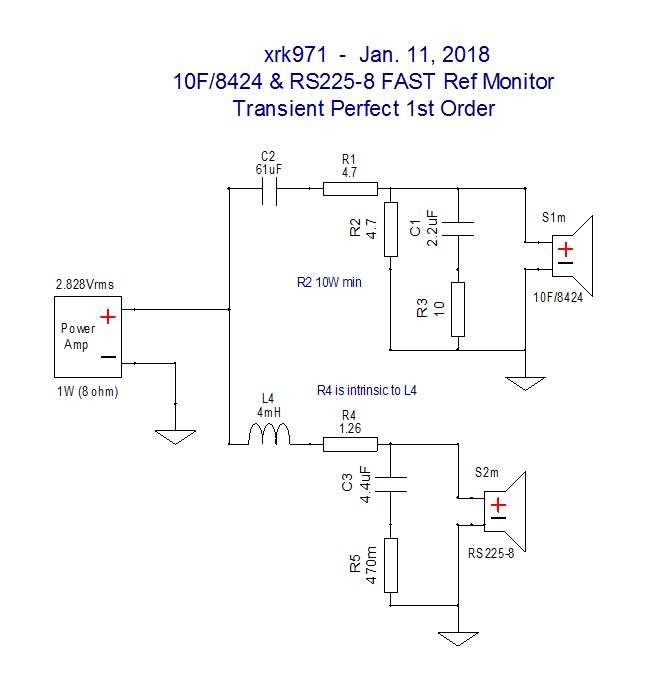
Put the woofer on top for best time alignment.
Looks like this:
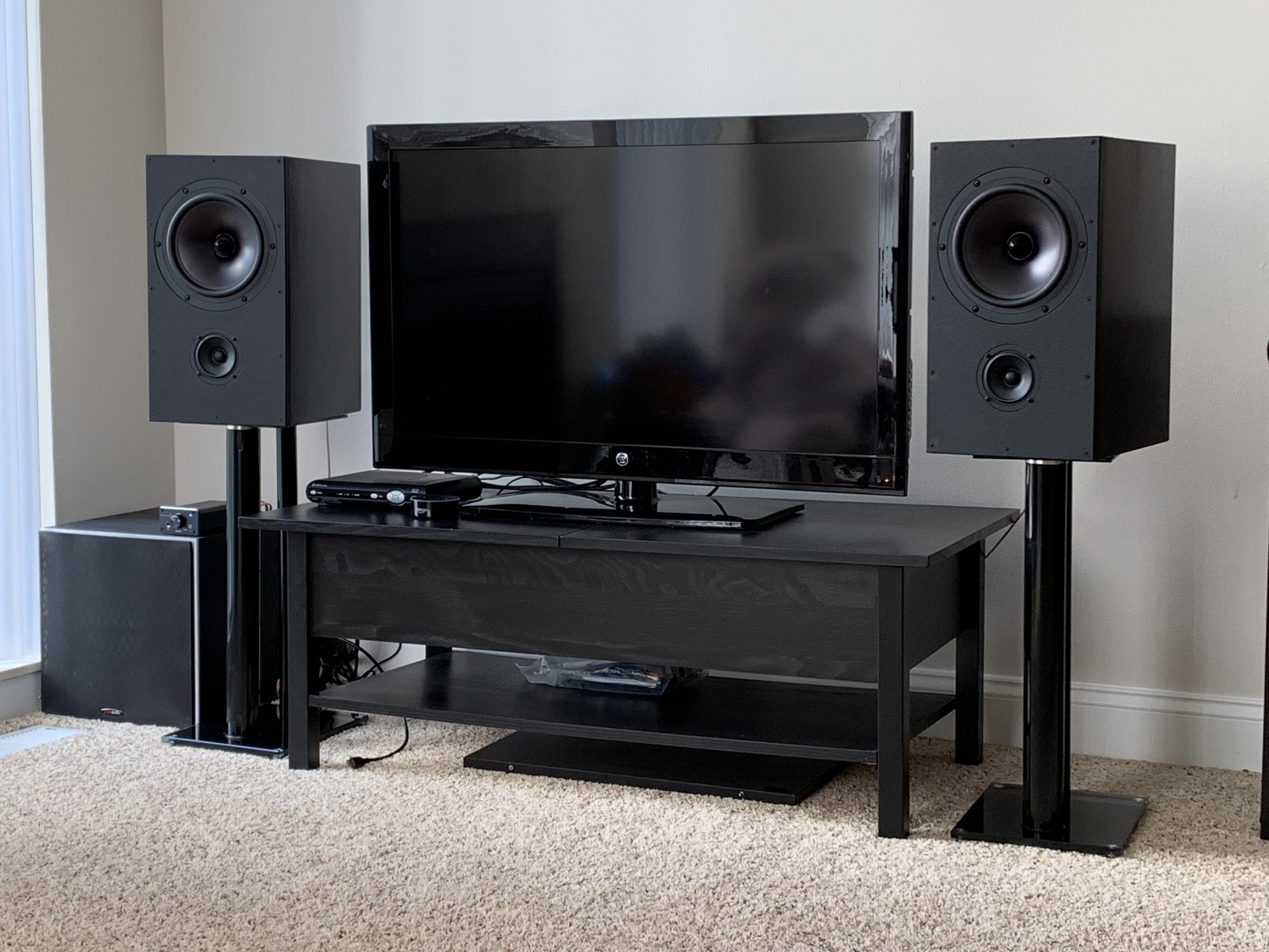
10F/8424 & RS225-8 FAST / WAW Ref Monitor
Here is the XO:
Put the woofer on top for best time alignment.
Looks like this:
Last edited:
As nerdy as i am, i messed around with this data for maybe an hour and came to this. It's a second order serial crossover without zorbel or bsc as it looks best without, but with a notch filter to tame the treble. 1st order and parallel crossovers did not work well with this setup for one or the other reason. You find the project files included.
Attachments
Last edited:
I like series XOs, one of the times i did a passive i couldn’t get anywhere w parallel, th eseries just popped.
Isn’t this 2nd order:
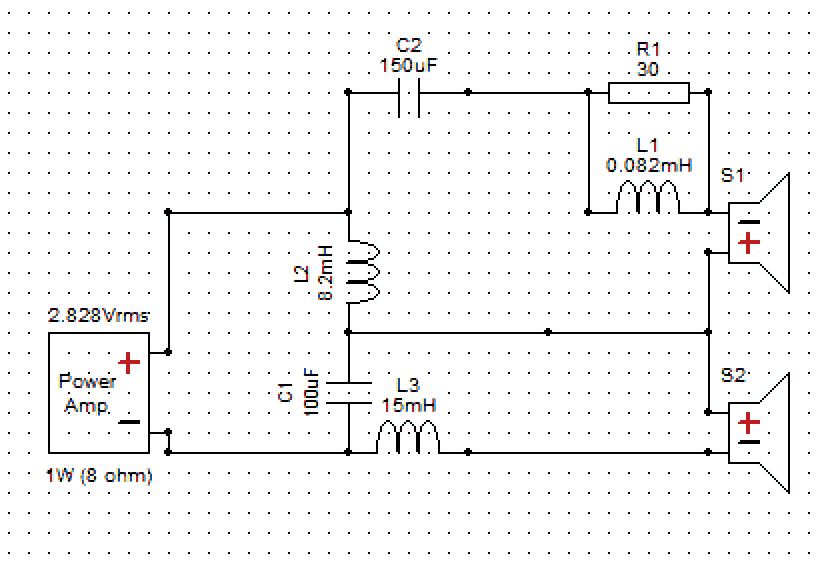
dave
Yes it is, altough i'm a big 1st order fan, sometimes it's just not fit like here. Th OP crossovers too high to my taste, and the 6M does not go low enough to crossover low with it in 1st order. I do 1st with my 10M and that works, but here a second order is needed.
180Hz as you can see in the graph. That's where i like to crossover FR (the 150-250 band) so there is no crossover in the frequency band where i find it disturbing (the 300-4K band). It's there that the phase issues that every crossover has, are most heared by me and where it disturbs me. Above or below is ok for me altough i prefer no crossover at all if possible...
It's because i crossover so low that i need a 2nd order, a first order would cause gaps in the lower part of it as the 6M does not go low enough.
It's because i crossover so low that i need a 2nd order, a first order would cause gaps in the lower part of it as the 6M does not go low enough.
I am not sure why you want to force the full range down so low. There is no need to go to 180Hz to get the fullrange magic. 500Hz to 700Hz is great as that allows much lower membrane displacement on the fullrange, thereby limiting cone motion induced harmonic distortion. Furthermore, the mid bass punch and slam provided by the much bigger woofer is much more visceral when powered by an 8in or 10in woofer vs a 3.5in “woofer”. A lot of this depends on how well behaved the woofer is so you can let it work up much higher. But making a 3.5in fullrange go to 180Hz really drives audible distortion levels up.
180Hz
I only cross that low when i have a real wide baffle. Our A7.3eN w 2 SDX7eN is the only example so far.
We tried 180 on an FF85wKeN WAW, it sounded really good, but 250 was better, giving a more viceral impact.
But we always use fairly extended mid woofers — about 1700 hz on the SDX7 above but all the others good to at least 4k (and th e little Peerless we 1st used with the FF85kWeN could be said to reach out to 10k as does the Alpair 12pWeN. And mostly 1st order XOs and drivers closer than a 1/4 wavelength at the XO which makes them essentially coincident.
dave
Put the woofer on top for best time alignment.
Get the C-C small enuff and it makes little difference.
And when you are thinking about ann enclosure for the midTweeter one can use a 4/5” D chunk of PVC pipe out the back to be an aperiodic midTL.
X’s long triangular pyramid works too.
dave
I am not sure why you want to force the full range down so low. There is no need to go to 180Hz to get the fullrange magic. 500Hz to 700Hz is great as that allows much lower membrane displacement on the fullrange, thereby limiting cone motion induced harmonic distortion. Furthermore, the mid bass punch and slam provided by the much bigger woofer is much more visceral when powered by an 8in or 10in woofer vs a 3.5in “woofer”. A lot of this depends on how well behaved the woofer is so you can let it work up much higher. But making a 3.5in fullrange go to 180Hz really drives audible distortion levels up.
To be honest, i never use FR that are so small, but here you may have a point for the 6M. But with 5-6" and bigger FR you can easely without audible distortions, that is one of the reasons i like those more. But here in simulation the driver seems to behave good in a 2nd order CR, not in a 1st order. I did not do a real test, it was just an illustration of what i had in mind as CR for this combo.
But a 6" like my 10M Gen 3 has punch and slam, i tried to do higher cr with my minidsp before i did build the analog version on my personal waw (Alpair 10M Gen3 and Scanspeak 26W-8534G00), and it did not work for me. When going above 250Hz the phase issues of the CR start to disturb me. Now it's a 1st order serial CR at 180Hz and that is much better, and also have a lot of punch and no audible distortions also.
I only cross that low when i have a real wide baffle. Our A7.3eN w 2 SDX7eN is the only example so far.
We tried 180 on an FF85wKeN WAW, it sounded really good, but 250 was better, giving a more viceral impact.
But we always use fairly extended mid woofers — about 1700 hz on the SDX7 above but all the others good to at least 4k (and th e little Peerless we 1st used with the FF85kWeN could be said to reach out to 10k as does the Alpair 12pWeN. And mostly 1st order XOs and drivers closer than a 1/4 wavelength at the XO which makes them essentially coincident.
dave
You don't target most of your speakers as low as i do. I listen too a lot of bass heavy music (like reggae, dub, hiphop and even some classic music), wich won't work with most of your speakers as they mostly cut of much higher than 30Hz (my target). For more midrange based pop, rock and jazz your speakers are very good (at least those i heared, wich are some of the fonkens and the frugalhorns).
So my woofers are more subwoofers that go lower and not midwoofers. And my speakers are mosly wider than yours as i like the sound of big boxes in stead of dsp eq to force drivers to go lower. It's just a different philosophy on this. But both ways of working have their advantages and disadvantages. It's a matter of choices
… witch won't work with most of your speakers as they mostly cut of much higher than 30Hz
My current speakers go to 25 Hz.
(at least those i heared, wich are some of the fonkens and the frugalhorns).
Trying to push a FR loud & low is not a good idea, or try to go loud.
That is why we have WAWs
So my woofers are more subwoofers
All speaker design is a compromise. Subs usually cannot be pushed too high or they start getting ugly. Best to use subs below the midWoofers (now a coupler driver) in the WAW for a 3-way.
And my speakers are mosly wider than yours...
Tysen are fairly skinny, but their compactness is one of their goals, the current MTMs are 40 cm wide, the Ellipsa waiting in the wings (sorry SOnus Faber thw name stuck) are 54 cm.
dave
Trying to push a FR loud & low is not a good idea, or try to go loud.
That is why we have WAWs
I know that, i also use a WAW as main set.
Tysen are fairly skinny, but their compactness is one of their goals, the current MTMs are 40 cm wide, the Ellipsa waiting in the wings (sorry SOnus Faber thw name stuck) are 54 cm.
dave
My Alpair/scanspeak WAW is 50cm wide, and the speakers i design or build for others are also rather wide. But most speakers on your site are much skinnier than that. And that is also what most people search, speakers that don't take a lot of space and have a big output. But i like the sound of a speakerbox where the drivers have space to move, not that of those too small boxes that need a lot of amp and dsp power to get the response they want from the speakers...
Another consideration is that if one looks at the 10 octaves we are ideally going to cover.
20-40-80-160-320 (thats) helf way 320-640-1.25k-2.5k-5k-10k-20k the other half.
And, althou just an average, the energy distribution of typical music also has a midpoint at about 300 Hz.
waxx is using the FR to cover 6 octaves (me also w the widest one of our WAW), X about 4, typically i am targeting that half.
That is one trade-off.
And we have mentioned…
1/ baffle step (largely = box width)
2/ driver centre-centre
3/ how loud do you need (more loud, cross higher)
4/ passive or active XO (below a certain point, active XOs get cheaper, and are usually easier to get good)
5/ how hign does the midBass go?
And you have to deal with the drivers you have and your taste.
dave
20-40-80-160-320 (thats) helf way 320-640-1.25k-2.5k-5k-10k-20k the other half.
And, althou just an average, the energy distribution of typical music also has a midpoint at about 300 Hz.
waxx is using the FR to cover 6 octaves (me also w the widest one of our WAW), X about 4, typically i am targeting that half.
That is one trade-off.
And we have mentioned…
1/ baffle step (largely = box width)
2/ driver centre-centre
3/ how loud do you need (more loud, cross higher)
4/ passive or active XO (below a certain point, active XOs get cheaper, and are usually easier to get good)
5/ how hign does the midBass go?
And you have to deal with the drivers you have and your taste.
dave
But most speakers on your site are much skinnier than that.
That is very true, but the are also almost exclusively for FR drivers that are no larger than 6.5”. The design i am most proud of is the small micro-size trapezoids for the FF85 and A5.2. They also can be done with helper woofers and evolved into our 2 Tysen WAW variations.
dave
That is very true, but the are also almost exclusively for FR drivers that are no larger than 6.5”. The design i am most proud of is the small micro-size trapezoids for the FF85 and A5.2. They also can be done with helper woofers and evolved into our 2 Tysen WAW variations.
dave
Well, my best sounding box for this alpair 10M driver (nominal 6", in reality 5.5 or so), is a 50cm wide ported cabinet with 2 ports on the side of the front, like seen in this picture. It's a 25L cabinet shallow cabinet and on it's own tuned to 40Hz, but mostly used with the subs below it. The total box is bigger because behind it is the space for the crossover network in a seperate space.
Attachments
- Status
- This old topic is closed. If you want to reopen this topic, contact a moderator using the "Report Post" button.
- Home
- Loudspeakers
- Full Range
- FAST (WAW) build help and opinions
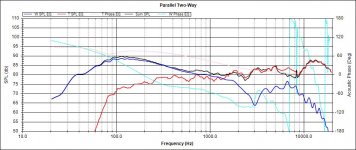
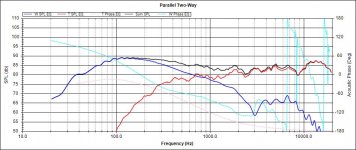
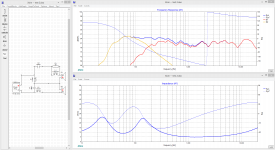
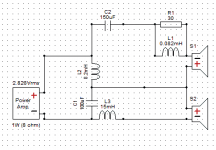
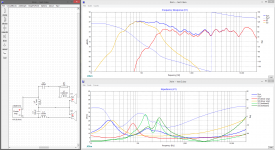
![IMG_0967[1].jpg](/community/data/attachments/699/699549-f6e4f836f0e8af35a737e96597026cc8.jpg)